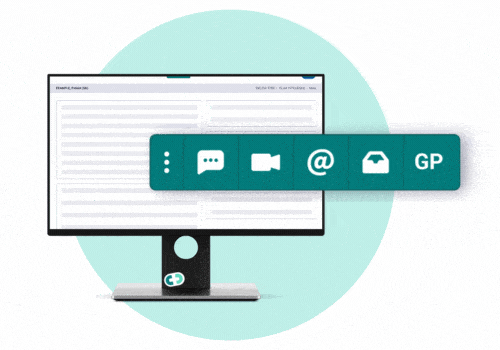GPSoC it to ’em
- 2 December 2013

Visiting the website of EHI Primary Care is no longer a matter of dread for Kemi Adenubi; but years ago it was a scary experience.
“Pretty much every week there was something about the difficulties GPs were having exercising choice for their systems and dates not being met,” she says. “Essentially I was brought in to try to deliver something new.”
Starting something new
Adenubi started working in healthcare ten years ago, joining the National Programme for IT team as an external consultant on an initial six-month contract to help deliver N3, the NHS’ broadband network.
She became an employee four years later and now heads up not just the GPSoC programme, but also GP2GP, the Electronic Prescription Service, and the new GP payment system CQRS.
GPSoC is a framework contract that funds GP IT systems for around 80% of practices in England and gives practices the choice of which system to use.
It replaced the initial approach of the National Programme for IT, which started out with the aim of getting all practices in a particular area to use the system chosen by their local service provider.
Adenubi explains that after running a number of procurement programmes she “wanted to not just hand over a procured contract for someone else to run”, but to run one herself.
“When we first implemented [GPSoC] people thought it would run itself – that it was just a framework people would pick things off – but actually there were plenty of things we needed to do with the users and suppliers to make it work properly,” she says.
Opening up a ‘closed world’
Before the national programme was set up, GP systems were owned by practices and there was very little information available about the performance of systems.
“It felt like a very closed world, in which a practice only received information from their suppliers, and it wasn’t easy to make comparisons between systems. GPSoC was created because people wanted to have choice; so we set-out to make sure people were making informed choices,” Adenubi explains.
Initially, however, people simply did not believe Adenubi when she said the GPSoC programme would deliver choice. Relationships were difficult and much of her time was spent building trust.
Suppliers, meanwhile, thought different companies were getting different deals that would favour one over another. Adenubi’s team addressed this by deciding to have one, standard agreement that would be published openly.
“Once the suppliers understood we weren’t going to do side deals, and that we were saying the same things to everybody, that was positive. With users, it was about listening and helping to solve some of their issues because their biggest bugbear was about not being able to exercise choice,” she says.
The programme also set up a PCT-practice agreement setting out what the primary care trusts were responsible for and what practices must do. This got 99% sign-up and is being carried over to become the clinical commissioning group practice agreement.
Becoming a champion
EHI’s Healthcare IT Champion of the year award is a special category of the annual EHI Awards. Readers put forward nominations and the winner is decided by a reader vote.
Winning the award is a certain indication that Adenubi is well-known and respected; and it’s easy to see how her direct, honest style and keen intelligence has gained admirers on all points of the primary care landscape.
GPs are a lively and engaged bunch, but can be a tricky group to please, while primary care, like all areas of health, is highly political. Adenubi also has a number of large incumbent suppliers to handle, with plenty of others knocking on the door, wanting to join the party.
Her ability to manage these varying interests and relationships effectively, means that of all the projects that the national programme delivered, GPSoC is arguably the most popular.
Adenubi says she was “a bit embarrassed” to be nominated as Champion, but enjoyed it when people from a range of organisations said they had voted for her.
“It’s been really nice to have people voting for me and people were so happy when I won,” she says. “As a project we delivered on the things we said we would do; and I think that’s just fabulous.”
GPSoC version 2
The first round of GPSoC contracts were signed in 2007 and are due to expire in March this year. However, they have been extended so new contracts can be put in place.
This was originally expected to happen by the end of this year, but Adenubi says she and her team are now aiming the new contracts to be in place from the end of March next year.
Ninety suppliers responded to the initial tender released in May, worth up to £1.2 billion over two years. “It was positive that we attracted the market’s interest, but it’s given us an issue about managing capacity,” Adenubi explains.
The first lot of the tender, ‘GP clinical IT systems and subsidiary modules’, is funded centrally and covers the core GP clinical IT system suppliers as well as subsidiary clinical systems and services that interoperate with the principal systems.
This new approach has opened up the market for third-party suppliers to provide patient transactional services, patient clinician communication and patient record access.
Adenubi’s team is now working with a “manageable” 19 suppliers in the first lot. But this is still considerably more than the four core system suppliers it would have been handling if GPSoC2 had simply re-procured what the original scheme provided.
Plans for the remaining two lots are on hold until early 2014 while the team focus on negotiating contracts with this first group of suppliers.
Interfacing
One of the key requirements of the GPSoC2 is that principal suppliers must open their interfaces to allow subsidiary systems to interoperate with them.
This is not a new concept, as all the suppliers already have interfaces, but Adenubi says they are selective about who they interface with.
They also tend to want to retain full control over who has access to the data held in their systems, even though it belongs to the NHS. Also, the cost of interfacing is “not at all transparent.”
“The challenge is not technical, but about getting all the suppliers to come up with a good standard of interface delivery,” Adenubi says. “It’s a key plank that anyone who wants to come on to the framework has to meet the interface requirements.”
Adenubi has been working with the principal suppliers for many years and recognises that they have delivered systems people want and are respected for that.
Forcing them to open up is therefore “not about diminishing the importance of these systems to us, but about building in more suppliers and functionality delivered to practices and patients.”
“The more good suppliers we have in this space, the more opportunity we have to deliver on the interoperability challenges people have been talking about for so many years,” she argues.
Steel in the bones
Despite their long history with the NHS, Adenubi also says suppliers should not be complacent; they should not believe that GPSoC must sign a contract with them because of their customer base.
“We are planning for success and saying we will sign up all the principal system suppliers, while also knowing what our strategy is if we can’t reach a deal with them; otherwise we don’t have a successful negotiation,” she adds.
Her team is working with the principal suppliers to be clear about what costs they incur for providing interfaces and the GPSoC contract will pay for that work to be done once, so third parties do not have to pay charges.
Initially, there will have to be some integration testing undertaken by the principal suppliers, but ultimately, the HSCIC is looking to standardise the interface mechanisms so the integration process is the same with each supplier. “If we can get this to work properly it will be revolutionary,” she says.
The plan is to refresh the framework and run more procurements no sooner than 18-months after the next contracts are signed. “We should by then have standard interfaces in place so it will be a lot easier for smaller suppliers to be able to get on it,” Adenubi says.
Final thought
While she’s happy to read EHI Primary Care these days, Adenubi doesn’t want to take all the credit for the turn-around of GPSoC herself; or to suggest that she has all the answers going forward.
“It sounds like a cliché to say that I couldn’t have delivered this without a strong team, but it’s true,” she says.
“Between us – GPs, suppliers and the team – we have a massive challenge ahead to make the new arrangements work effectively and safely. I believe we are up to it and I’m looking forward to what the next couple of years will bring.”




